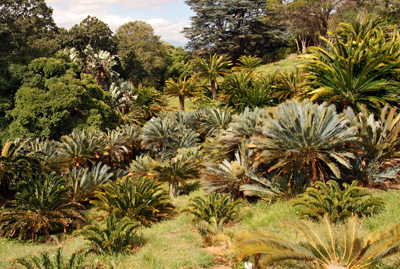
Cycads are an ancient group of vascular plants that were once a prominent component of the world’s flora. The oldest cycad fossils date to the early Permian (280 million years ago) or late Carboniferous period (300–325 million years ago). During the Jurassic Period they were so common that the period is sometimes referred to as the “Age of Cycads” (along with the dinosaurs). In the modern world they are restricted to tropical and subtropical regions and are no longer a dominant plant type. As a group they have not changed much since the Jurassic, compared to the major evolutionary changes that took place in other plant groups.
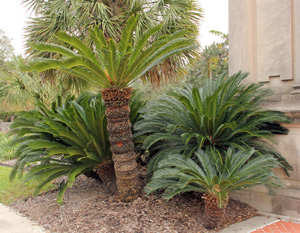
The greatest diversity of these “living fossils” is in South and Central America. More than 70% of the world’s cycad species occur in hotspots of diversity there and in Australia, South Africa, Mexico, China and Vietnam, but they also occur in the southeasten US, Asia, India, Polynesia, Micronesia and elsewhere. They occupy a variety of habitats. Some are native to wet rainforests while others are from semidesert climates; others grow in grasslands or seasonally dry forests. They may be found growing in rich, organic soils, sand, or rock, in swampy soils or even in halophytic (salty) soils. Some species grow in full sun, while others need full to partial shade. Some even tolerate frost and snow.
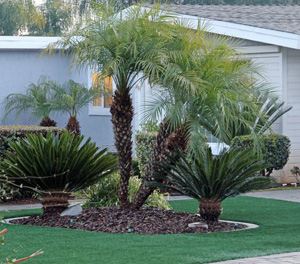
With large compound leaves and often a thick trunk, they superficially resemble palms – and therefore often have a common name including “palm” even though they are not related to true palms – but are actually most closely related to gingko! Many species are used as ornamental plants in mild climates and a few are grown as indoor or house plants in colder areas. Many species have restricted ranges and are facing possible extinction in the wild. Cycads are long-lived, don’t reproduce frequently, and most populations are small, putting them at risk of extinction due to unscrupulous collection from their natural habitats, habitat destruction and devastating environmental events (floods, fire, drought, etc.). All species of cycads are CITES* regulated, although seeds from species on Appendix II are not.

Cycads have a cylindrical, usually unbranched, trunk of spongy wood. The evergreen leaves grow in a rosette directly from the top of the trunk, creating a crown of foliage as the plant ages and the older leaves fall off. The leaves are often quite large relative to the size of the trunk. The pinnate leaves are typically hard and stiff or leathery, although they are very tender when they first emerge.
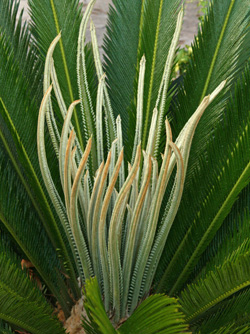
The central leaf stalk either has leaflets emerging perpendicular to the stalk (compound) or the leaf edges are so deeply incised they appear compound. Leaflets can be directly opposed or alternating, and smooth-edged or toothed. The leaf stalks are produced in varying numbers, usually in one or more flushes each year. The trunk ranges from a few inches to many feet tall, depending on the species but in some the trunk is buried so it is not apparent. Plants generally grow slowly and live a long time. Some specimens are estimated to be hundreds or perhaps a thousand years old.
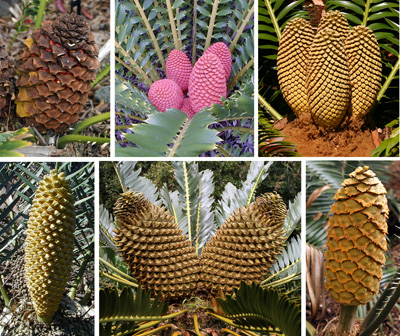
Cycads are dioecious (male and female reproductive parts are on separate plants). Like other gymnosperms they produce cones instead of flowers. Many of these cones are very ornamental. Pollination is often accomplished by beetles, especially weevils, or small bees. Some species of cycads produce heat or odors to attract these pollinators. As the cone matures, it opens to reveal the large seeds.
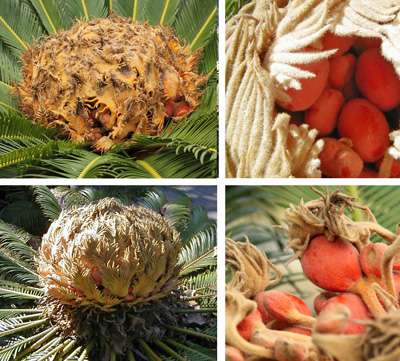
The mature seeds tend to be colorful – often bright red, purple or yellow – to attract a variety of birds and mammals which disperse the seeds.
There are over 300 described species of cycads living today, in 10–12 genera and 3 families (and several more extinct genera and families). There are likely many more undescribed species, based on the rate of discovery in recent years, especially in Asia and South America where endemism is high. The three families can be identified by looking at the central stalk of the leaf.
- The family Cycadaceae has a single genus, Cycas, with 105 species primarily in Asia to southern Japan, Australia, the western Pacific Ocean islands and Africa. In this family there is only one vein running up the center of the leaf stalk from top to bottom.
- The family Stangeriaceae has only 3 living species, Stangeria eriopus from southern Africa and two species of Bowenia in Queensland, Australia. The leaves are reminiscent of fern fronds – so much so that Stangeria was first described as a fern! This group has the central vein along the leaf stalk like the Cycadaceae but also has lateral veins.
- The family Zamiaceae has a broad geographical range suggesting it evolved before the supercontinents of Laurasia and Gondwana separated.There are many important genera in this group including Dioon (13 species in Mexico and Central America), Encephalartos (66 species in southeast Africa), Macrozamia (41 species in Australia), Ceratozamia (26 species in southern Mexico and Central America), and Zamia (65 species in the Americas from Georgia to Bolivia). The leaf stalk of plants in this family has more than one central vein, all of which are parallel to each other.
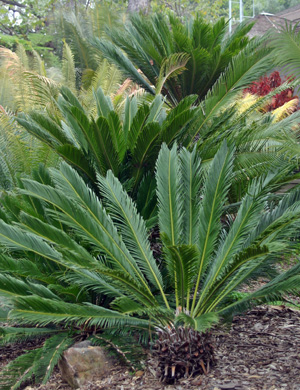
Some noteworthy cycad species include:
- Cycas revoluta, sago palm or king sago, is a popular and widely cultivated species with stiff, glossy, deep green fronds that almost look plastic. Native to subtropical areas of southeastern Japan, it thrives as an indoor plant if abundant light can be provided. It prefers bright light but will tolerate moderate light levels. This is one of the more cold-tolerant species, surviving to about 15ºF (zone 8), although the leaves may be frost-damaged when temperatures drop to the high teens. It tolerates dry conditions, so allow the growing medium to dry out between waterings (except when it is pushing new leaves). Variegated forms occur, but are rare.
-
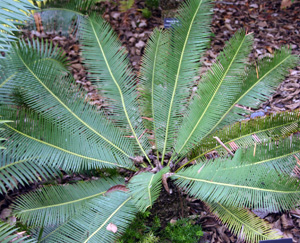
Dioon edule.
Dioon edule is a Mexican and Central American species with edible seeds, although container-grown plants are unlikely to produce any seed. It can grow up to 9 feet tall but does well in containers. It can withstand the occasional light frost. It is the most widely cultivated species in this genus. - Encephalartos species (including E. laurentianus, E. horridus, E. altensteinii, E. lehmannii, and E. villosus, among others) are becoming increasingly popular as landscape plants in mild climates.
-
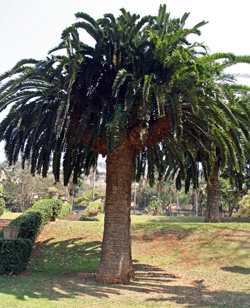
Encephalartos woodii at the Durban Botanical Garden, South Africa.
Encephalartos woodii is an African species that is extinct in the wild and all living specimens are male clones. They exist at numerous botanic gardens around the world. - Zamia furfuracea (may be listed as Z. maritima), sometimes called cardboard palm or other common names, comes from coastal sand dunes in Mexico. It is a common houseplant that is tolerant of low humidity and relatively low light found in homes. The thick, olive green, oval leaflets have a soft, reddish fuzz on the undersides that supposedly feels like cardboard to the touch. It is a popular landscape plant for mild climates.
- Zamia pumila (= floridana) and/or integrifolia is native to the southern US (Georgia and Florida) and several islands in the Caribbean. The taxonomy of this group is confused, being variously considered one, two, or more distinct species. These plants with with the common name of coontie (a Seminole name), Florida arrowroot, or Seminole bread have dark green, elliptical leaves. The new foliage is covered with short, rusty-brown hairs. They have subterranean stems and are adaptable to many conditions, and make a good bonsai specimen.
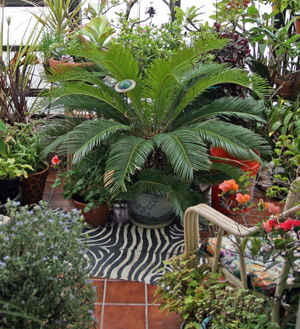
There are many species of cycads that are easy to grow as houseplants. The growing medium must have good drainage. Cactus mix works well, or use a peat-moss based potting mix amended with 30-40% coarse sand and/or Perlite, horticultural pumice or baked clay granules. They do not mind being root-bound, so they don’t need frequent re-potting and can be underpotted.
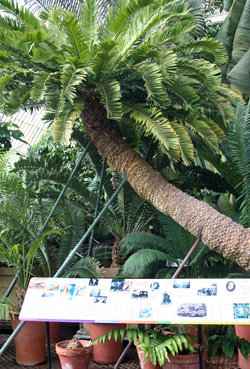
They are best repotted in spring or summer. Although cycads in general are slow growing and will tolerate neglect, with sufficient light, moisture, and nutrients many will increase in size and mature quite quickly.
Cycads tend to have an episodic growth pattern, with each flush of new leaves emerging all at once. In habitat, many cycads produce leaves, at most, once a year and produce cones only sporadically. As houseplants, they may only produce leaves every two years and remain somewhat the same size for many years (one reason they can be excellent as bonsai specimens). However, most species of cycads can cone every year and produce multiple leaf flushes each year with the proper light and fertilization (with a high nitrogen fertilizer; but be aware that over-application can kill plants).
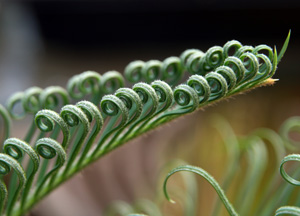
Most cycads need to have their growing medium kept uniformly moist (but with good drainage!). This is critical when plants are leafing out, from emergence until they begin to harden several weeks later, otherwise the tender new growth may scorch or the leaves will harden in a curled instead of flat position. However, one of the most common causes of cycad death is over-watering, so moisture levels should be monitored carefully.
Other problems include infestations of scale insects or occasionally mealybugs which can be difficult to control. Container-grown plants can be moved outside seasonally but be sure to acclimate the plants to brighter light to prevent sunscald, and check carefully for pests before moving indoors in the fall.
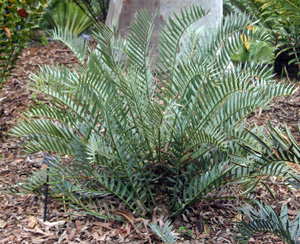
The older and lower leaves of cycads can be removed to improve the appearance of the plant. Cut off any leaves that have turned yellow or brown at any time, removing them at the base near the trunk. If all the leaves are removed, the plant should produce a new flush of leaves.
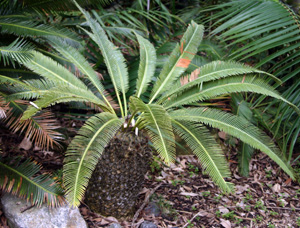
Unless you are really into plant propagation, you probably want to just buy and enjoy purchased plants. However, cycads can be propagated by seeds or division. Seeds have no dormancy, so must be planted when very fresh but even so germination is often slow and variable.

Many species eventually produce offsets at the base of the plant, or occasionally in the crown, which can be separated and potted up once they are about 2 inches in diameter. Remove the “pup” from the parent plant with a trowel, shovel or knife, and pot up with the same growing medium as for a mature plant. Most or all of the leaves should be removed and roots are not essential as the pup will produce a new set of both roots and leaves once it gets established. The small plant should be positioned so that half of the trunk is submerged in the growing medium and half is exposed. Water deeply but sparingly until roots have formed (a few months) or it might rot. A new leaf or flush of leaves will be produced after the roots are established.
– Susan Mahr, University of Wisconsin – Madison
*CITES = Convention on International Trade in Endangered Species





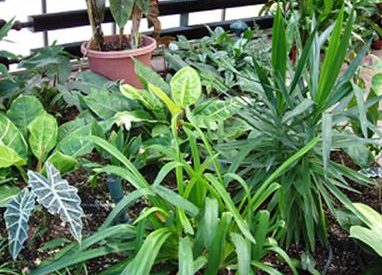 Houseplant Care
Houseplant Care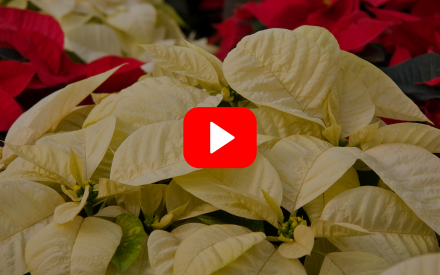 ▶ Watch: Maintaining Your Festive Houseplants
▶ Watch: Maintaining Your Festive Houseplants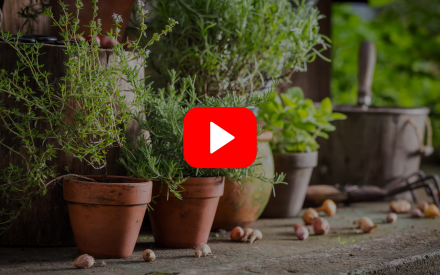 ▶ Watch: Bringing the Garden Inside
▶ Watch: Bringing the Garden Inside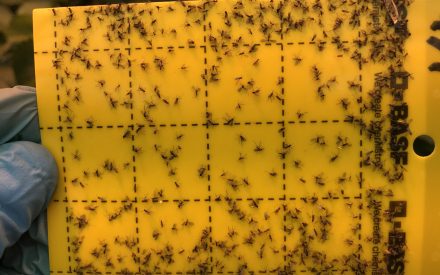 Fungus Gnats on Houseplants
Fungus Gnats on Houseplants


